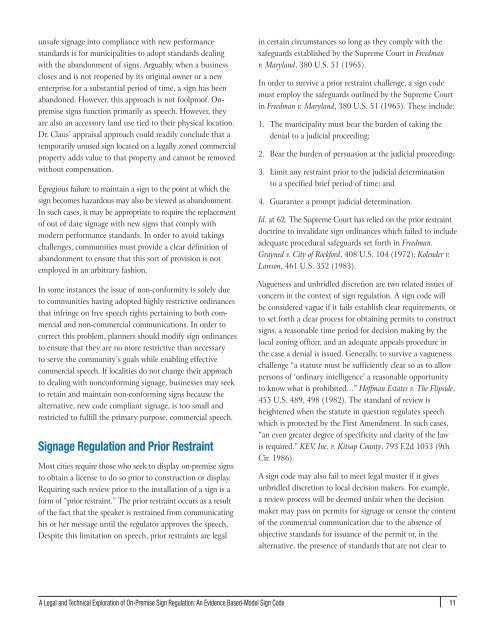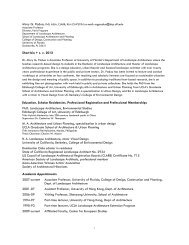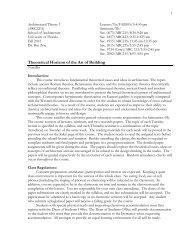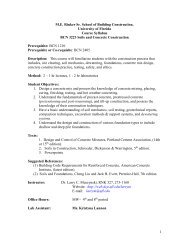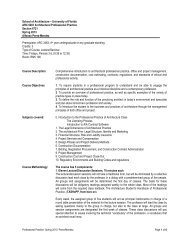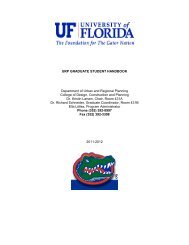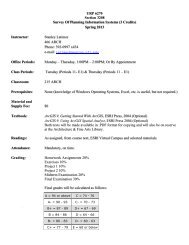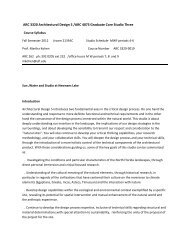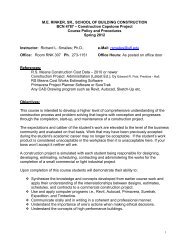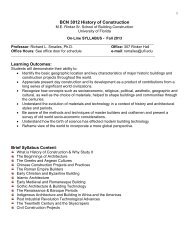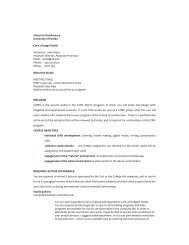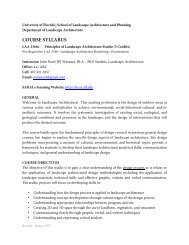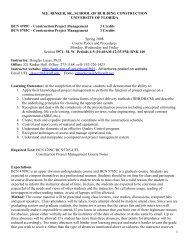An Evidence Based Model Sign Code - College of Design ...
An Evidence Based Model Sign Code - College of Design ...
An Evidence Based Model Sign Code - College of Design ...
You also want an ePaper? Increase the reach of your titles
YUMPU automatically turns print PDFs into web optimized ePapers that Google loves.
unsafe signage into compliance with new performance<br />
standards is for municipalities to adopt standards dealing<br />
with the abandonment <strong>of</strong> signs. Arguably, when a business<br />
closes and is not reopened by its original owner or a new<br />
enterprise for a substantial period <strong>of</strong> time, a sign has been<br />
abandoned. However, this approach is not foolpro<strong>of</strong>. Onpremise<br />
signs function primarily as speech. However, they<br />
are also an accessory land use tied to their physical location.<br />
Dr. Claus’ appraisal approach could readily conclude that a<br />
temporarily unused sign located on a legally zoned commercial<br />
property adds value to that property and cannot be removed<br />
without compensation.<br />
Egregious failure to maintain a sign to the point at which the<br />
sign becomes hazardous may also be viewed as abandonment.<br />
In such cases, it may be appropriate to require the replacement<br />
<strong>of</strong> out <strong>of</strong> date signage with new signs that comply with<br />
modern performance standards. In order to avoid takings<br />
challenges, communities must provide a clear definition <strong>of</strong><br />
abandonment to ensure that this sort <strong>of</strong> provision is not<br />
employed in an arbitrary fashion.<br />
In some instances the issue <strong>of</strong> non-conformity is solely due<br />
to communities having adopted highly restrictive ordinances<br />
that infringe on free speech rights pertaining to both commercial<br />
and non-commercial communications. In order to<br />
correct this problem, planners should modify sign ordinances<br />
to ensure that they are no more restrictive than necessary<br />
to serve the community’s goals while enabling effective<br />
commercial speech. If localities do not change their approach<br />
to dealing with nonconforming signage, businesses may seek<br />
to retain and maintain non-conforming signs because the<br />
alternative, new code compliant signage, is too small and<br />
restricted to fulfill the primary purpose, commercial speech.<br />
<strong>Sign</strong>age Regulation and Prior Restraint<br />
Most cities require those who seek to display on-premise signs<br />
to obtain a license to do so prior to construction or display.<br />
Requiring such review prior to the installation <strong>of</strong> a sign is a<br />
form <strong>of</strong> “prior restraint.” The prior restraint occurs as a result<br />
<strong>of</strong> the fact that the speaker is restrained from communicating<br />
his or her message until the regulator approves the speech.<br />
Despite this limitation on speech, prior restraints are legal<br />
in certain circumstances so long as they comply with the<br />
safeguards established by the Supreme Court in Freedman<br />
v. Maryland, 380 U.S. 51 (1965).<br />
In order to survive a prior restraint challenge, a sign code<br />
must employ the safeguards outlined by the Supreme Court<br />
in Freedman v. Maryland, 380 U.S. 51 (1965). These include:<br />
1. The municipality must bear the burden <strong>of</strong> taking the<br />
denial to a judicial proceeding;<br />
2. Bear the burden <strong>of</strong> persuasion at the judicial proceeding;<br />
3. Limit any restraint prior to the judicial determination<br />
to a specified brief period <strong>of</strong> time; and<br />
4. Guarantee a prompt judicial determination.<br />
Id. at 62. The Supreme Court has relied on the prior restraint<br />
doctrine to invalidate sign ordinances which failed to include<br />
adequate procedural safeguards set forth in Freedman.<br />
Grayned v. City <strong>of</strong> Rockford, 408 U.S. 104 (1972); Kolender v.<br />
Lawson, 461 U.S. 352 (1983).<br />
Vagueness and unbridled discretion are two related issues <strong>of</strong><br />
concern in the context <strong>of</strong> sign regulation. A sign code will<br />
be considered vague if it fails establish clear requirements, or<br />
to set forth a clear process for obtaining permits to construct<br />
signs, a reasonable time period for decision making by the<br />
local zoning <strong>of</strong>ficer, and an adequate appeals procedure in<br />
the case a denial is issued. Generally, to survive a vagueness<br />
challenge “a statute must be sufficiently clear so as to allow<br />
persons <strong>of</strong> ‘ordinary intelligence’ a reasonable opportunity<br />
to know what is prohibited…” H<strong>of</strong>fman Estates v. The Flipside,<br />
455 U.S. 489, 498 (1982). The standard <strong>of</strong> review is<br />
heightened when the statute in question regulates speech<br />
which is protected by the First Amendment. In such cases,<br />
“an even greater degree <strong>of</strong> specificity and clarity <strong>of</strong> the law<br />
is required.” KEV, Inc. v. Kitsap County, 793 F.2d 1053 (9th<br />
Cir. 1986).<br />
A sign code may also fail to meet legal muster if it gives<br />
unbridled discretion to local decision makers. For example,<br />
a review process will be deemed unfair when the decision<br />
maker may pass on permits for signage or censor the content<br />
<strong>of</strong> the commercial communication due to the absence <strong>of</strong><br />
objective standards for issuance <strong>of</strong> the permit or, in the<br />
alternative, the presence <strong>of</strong> standards that are not clear to<br />
A Legal and Technical Exploration <strong>of</strong> On-Premise <strong>Sign</strong> Regulation: <strong>An</strong> <strong>Evidence</strong> <strong>Based</strong>-<strong>Model</strong> <strong>Sign</strong> <strong>Code</strong> 11


